Badminton And Reaction Time Exercises For Improving Quickness And Reflexes (Malaysia)
In badminton, quickness and reaction time are crucial because the shuttle travels at high speed over a short distance, forcing fast decisions in both attack and defence. Badminton reaction time exercises are simple drills designed to train your brain and body to respond faster to what you see and hear. This guide is for kids, school players, and social adults in Malaysia who want to improve their on court speed. These exercises can help improve quickness and reflexes, but only if they are done regularly and combined with proper technique, footwork, and enough rest.
A badminton coach in Malaysia shares simple reaction time and quickness drills to help players in Kuala Lumpur move and react faster on court.
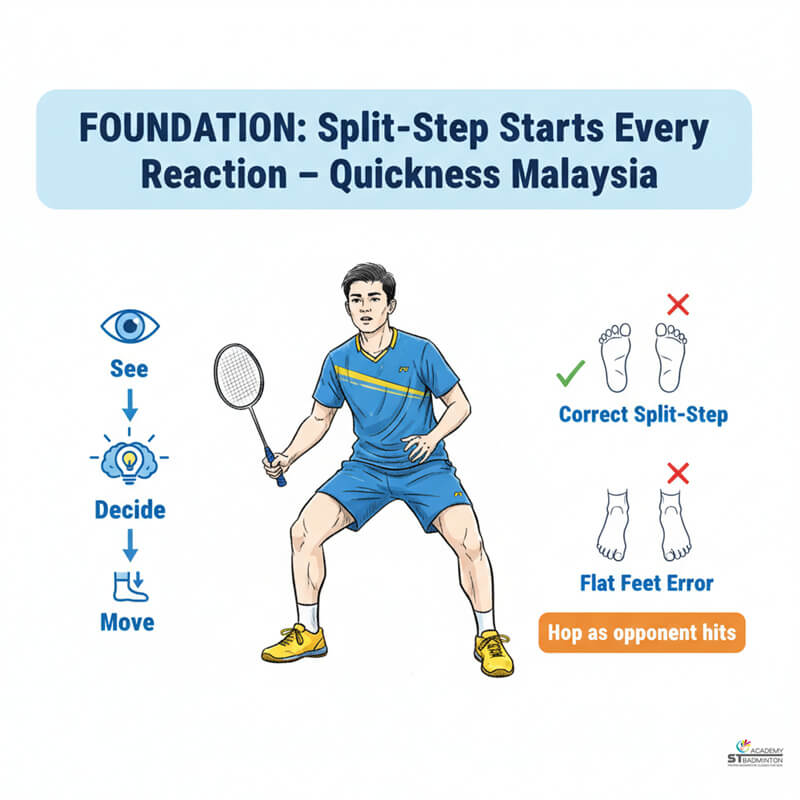
The Foundation of Speed
Footwork, Split Step and Reaction Time
To improve reaction time in badminton, we must first look at the feet. Your reaction might be fast, but if your body isn’t ready to move, that speed is wasted. The ‘ready position’ is your balanced home base, with knees bent and weight on the balls of your feet. From here, every quick movement starts with the ‘split step’ a small hop you make just as your opponent hits the shuttle. This simple action pre loads your leg muscles, allowing you to push off explosively in any direction. Without a well timed split step, you will always be one step behind, no matter how fast your brain reacts.
Think of it this way: reaction time training sharpens your brain’s signal, but the split step and proper footwork are what allow your body to obey that signal instantly. Many drills designed to improve badminton agility and reaction time are actually built around training this split step timing. If your feet are flat or you are standing too upright, even the best reflexes won’t help you reach a fast smash or a tricky net shot. Safety is also important; landing softly on the balls of your feet during the split step absorbs impact and prevents injury.
As a badminton coach in Kuala Lumpur, I always teach the split step as the first and most important part of quickness. For kids training in Setapak or Cheras, we make it a habit by calling out “split!” just before feeding a shuttle. This builds the automatic response needed for real matches. Good reaction time training for badminton always connects back to this essential footwork skill.

On-Court Drills
On-Court Quickness and Reflex Drills
The best way to get faster is to practice reacting to a real shuttle. These badminton quickness drills are designed to build game specific reflexes on the court.
One of the most effective drills is the multi shuttle random feed. A coach or partner stands on the other side and feeds shuttles to random corners of the court. The player’s goal is not just to return the shuttle, but to focus on a sharp split step and a quick first step to every shot. The feeder can control the speed to be suitable for different levels, from young kids in Wangsa Maju to competitive players in Petaling Jaya. For this drill, aim for high quality over quantity, do sets of 10 to 12 shuttles with good rest in between to ensure movements stay explosive.
Another excellent badminton reflex training exercise is the net reaction drill. The player stands near the net, and the coach stands on the opposite side, also at the net. The coach will randomly play either a tight spinning net shot or a fast, flat push towards the player’s body. This drill forces the player to react with their hands and racket very quickly in tight situations, simulating real net play. For kids, start with 3 sets of 1 minute. For adults, you can increase it to 3 sets of 2 minutes. Always maintain a good ready position with the racket up.
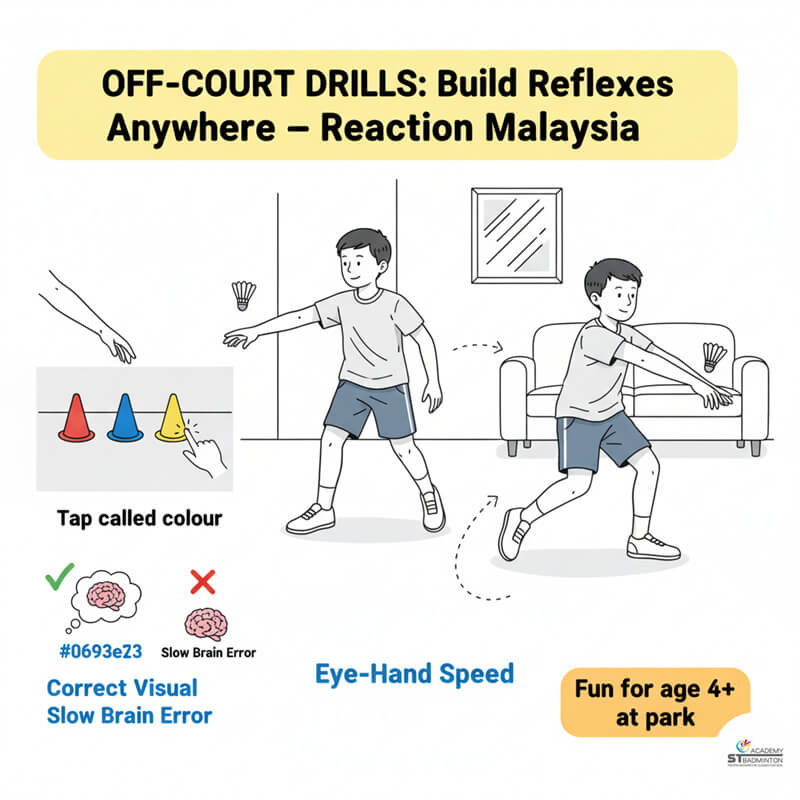
Off Court Drills
Reaction Time Exercises You Can Do Without a Court
You don’t always need a full badminton court in Kuala Lumpur to work on your speed. Many simple badminton reaction time exercises can be done at home, in a park, or at any open space. These drills are great for building the basic brain to muscle connection for faster responses.
A very simple visual reaction drill involves a partner and a shuttlecock (or a tennis ball). The player stands in a ready stance while the partner holds the shuttle out. The partner then drops the shuttle randomly to the left or right, and the player must move and catch it before it bounces twice. For a harder version, the partner can call “left” or “right” just as they drop it. This trains both visual and auditory reaction. Another popular one is the colour call drill, where you place different coloured cones on the ground and the player has to tap the correct cone as soon as the coach calls out the colour.
Wall reaction drills are also very useful. You can stand a few metres from a solid wall and hit a shuttle against it, trying to react to the unpredictable rebound. By changing your distance to the wall, you can make the drill easier or harder, forcing quicker responses. These shuttle reaction exercises are excellent for improving hand eye coordination and racket readiness, which is essential for defending fast shots.
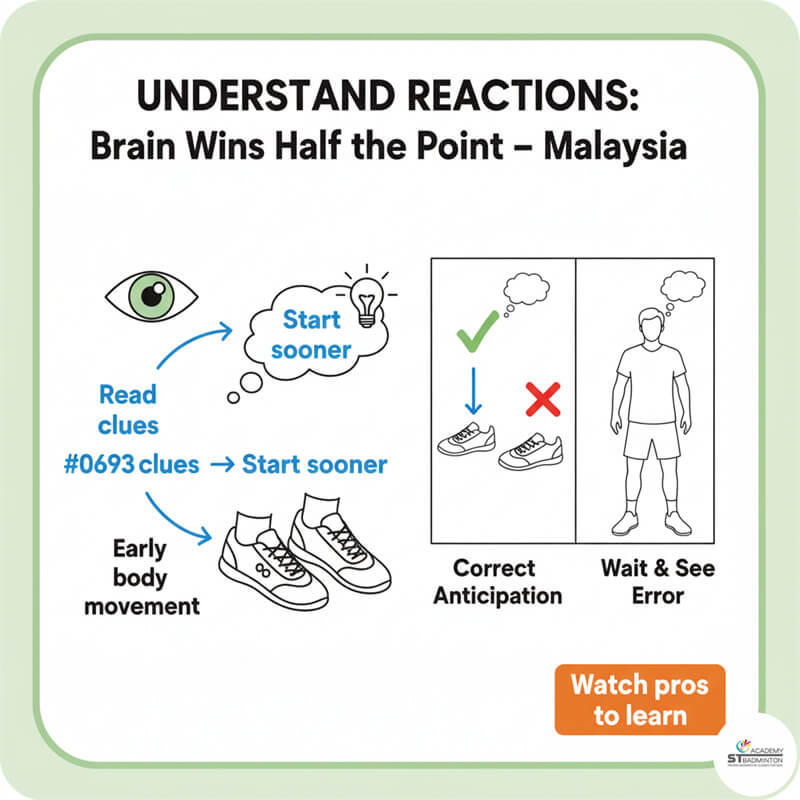
Understanding Reactions
How Reaction Time Works In Badminton
In badminton, reaction time isn’t just about moving fast. It’s a chain of events that happens in a split second. First, your eyes see the shuttle and read your opponent’s body language. Second, your brain processes this information to predict where the shot will go. Third, your brain sends a signal to your muscles to move. The time it takes for this entire process is your reaction time. Improving any part of this chain can make you seem much faster on court.
This is where anticipation comes in. An experienced player doesn’t just wait for the shuttle to be hit; they look for clues in the opponent’s preparation like their grip, their body position, and the start of their swing. By anticipating the shot, you can start your movement earlier, effectively cutting down your reaction time. This is why some players seem to reach every shot easily; they are not necessarily faster, but they read the game better.
Badminton training for quick reactions focuses on strengthening this chain. Drills that force you to defend against fast smashes, react to sudden net tumbles, or handle quick drives to the body all help to speed up this see decide move process. For players in Malaysia, from Johor Bahru to Kuala Lumpur, understanding that reaction is both a physical and a mental skill is the first step to becoming a quicker and smarter player.

Planning Your Training
How to Plan Reaction Time Training In Your Week
Consistency is key to improving your reflexes. You don’t need to do long, tiring sessions. Short, focused bursts of training are much more effective. Aim to include badminton reflex and quickness exercises into your routine 2 to 3 times per week. These sessions can be short, around 10 to 20 minutes each, and can be done as part of your warm up before your main badminton training or as a separate, short session on another day.
The type of drills should be suitable for the player’s age and level. For kids, especially those in primary school, it’s important to keep the drills fun and game like. Kids badminton reaction time training should focus on games like catching a dropped shuttle or tapping coloured cones. For older teens and adults in social clubs around Kuala Lumpur or Shah Alam, the drills can be more structured and repetitive, like multi shuttle feeding or wall drills, to really sharpen those automatic responses.
The most important rule is to keep the quality high. Reaction drills are meant to be fast and sharp. If you feel tired and your movements become slow and sloppy, it’s better to stop and rest. Quality is always better than quantity when it comes to reaction time training for badminton. Listen to your body and make sure the drills are challenging but not so difficult that they become frustrating.

What To Avoid
Common Mistakes With Badminton Reaction Time Exercises
As a coach, I see players make the same mistakes when trying to improve their reaction speed. Avoiding these common errors will make your training much more effective.First, training for too long. Reaction drills should be short and intense. If you train until you are exhausted, your movements become slow and your brain gets tired, which defeats the purpose. Keep sessions to 15 to 20 minutes max. Second, ignoring footwork and the split step. Many players only focus on moving their hands faster, but badminton speed starts from the ground up.
If your feet are slow to get you into position, a fast racket won’t matter. Always connect your reaction drills to proper badminton movement. Third, using drills that don’t feel like a real game. While general reaction apps can be fun, the best drills mimic actual badminton situations. Reacting to a shuttlecock is very different from tapping a screen. Finally, not getting enough rest. A tired mind and body will always react slower. Make sure you get enough sleep and recovery time between training sessions.
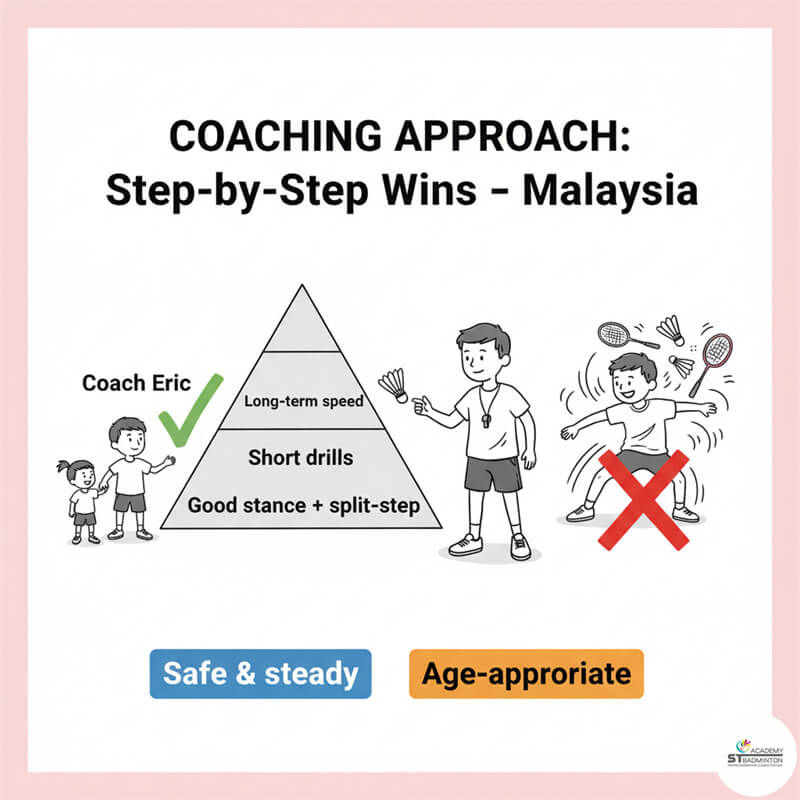
Our Coaching Approach
Why Step by Step Learning Matters
In badminton, trying to get faster without a plan can lead to bad habits. That’s why we emphasize a clear, step by step approach to improving quickness and reflexes. Players must first build a solid foundation with a good ready stance and a consistent split step. Only then can specific reaction drills be truly effective. We believe in building skills steadily, not just running around hoping to get faster.
With over 15 years of coaching experience in Malaysia, our method prioritises safe, technically sound development. To ensure every player gets the attention they need, our group sizes are capped at 4 to 6 students. This allows for constant, individualised correction, which is essential for mastering something as complex as reaction time and anticipation. Our training sessions have a clear plan that players and parents can see and understand.
FAQs About Badminton Reaction Time Exercises
Common questions from players and parents in Kuala Lumpur about reaction time training for badminton.
How often should I do badminton reaction time exercises each week?
For best results, aim for 2 to 3 short sessions per week. Each session should last about 10 to 20 minutes. It’s better to do short, high quality sessions consistently than one long, tiring session. You can add these badminton quickness drills to your warm up routine before your regular court time. This approach helps build reflexes without causing fatigue, which is crucial for players of all levels in Malaysia, from school teams in Kuala Lumpur to social players in Johor Bahru.
Can kids in primary school do quickness drills safely?
Yes, absolutely. For young children, the key is to make the drills fun and game based. Simple exercises like catching a dropped shuttle, tapping coloured cones, or reacting to a partner’s hand signals are safe and effective. The focus should be on developing coordination and quick responses, not on intense physical strain. A qualified coach in areas like Setapak or Cheras will ensure the drills are age appropriate, using proper warm ups and focusing on safe movements to protect developing joints.
How long before players see improvement in reaction speed and reflexes?
Improvement varies from person to person, but with consistent practice (2 to 3 times a week), most players will start to feel quicker and more responsive within 4 to 6 weeks. The first changes are often small like getting to a net shot slightly earlier or defending a smash more comfortably. True mastery takes longer, as it involves improving not just physical speed but also anticipation and reading the game. The key is patience and consistent effort with your reaction time training for badminton.
Do I need special equipment for badminton reaction training?
No, you don’t need expensive equipment to start. Many of the best badminton reaction time exercises use basic items like shuttlecocks, tennis balls, or coloured cones. A solid wall can also be a great tool for solo practice. While there are advanced tools like reaction light systems, the most important factors are a good plan, consistency, and a focus on quality movement. A partner or coach to feed shuttles or give signals is also very helpful for making the drills more game like and effective.
What is the difference between reaction time and footwork speed?
Reaction time is how quickly your brain can process what it sees and send a signal to your muscles to move. Footwork speed is how fast you can physically move your feet to cover the court once that signal is sent. You need both to be a quick player. A player can have very fast reactions but be slow on court due to inefficient footwork. That’s why good badminton agility and reaction time training always combines reflex drills with proper footwork technique, like the split step and lunging.
Are phone reaction apps useful for badminton players?
Phone apps that test how fast you can tap a screen can be a fun way to measure your raw reaction speed, but their benefit for badminton is limited. They only train your finger to screen reaction, not the full body movement required on court. A real game requires you to react with your feet, body, and racket not just a thumb. So, while they can be a fun supplement, they should never replace physical, badminton specific drills for players training in Kuala Lumpur or anywhere else in Malaysia.
Reaction Time Drills in Action
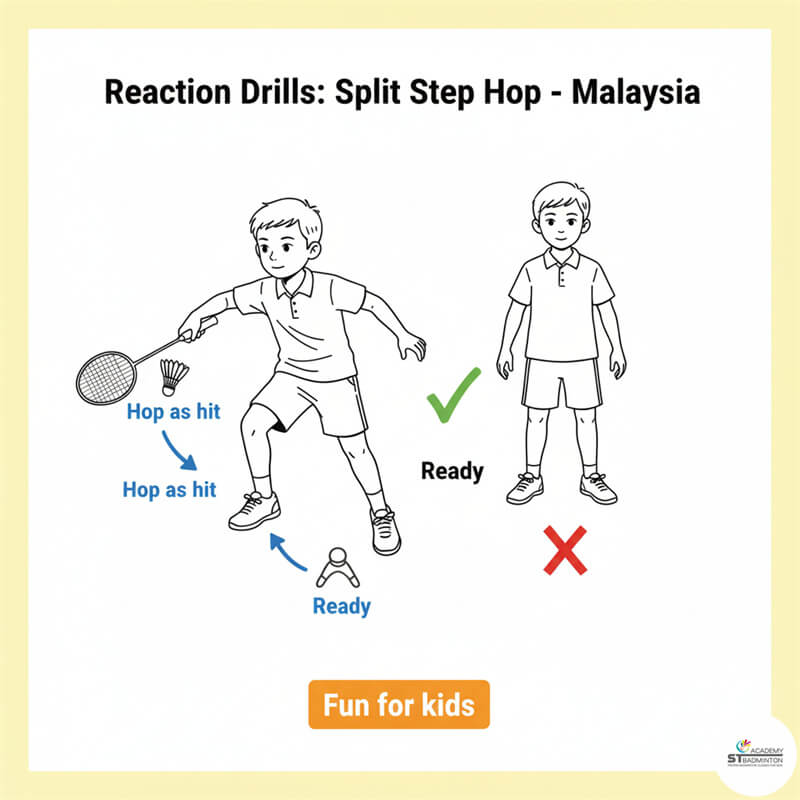

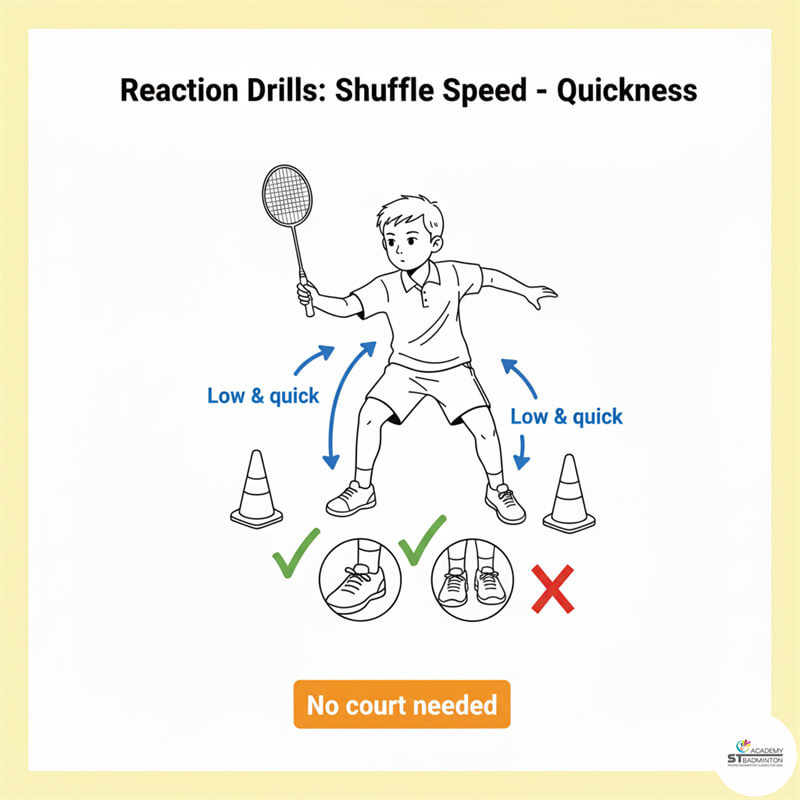

Benefits of Reaction Time Training
Starting with structured reaction and quickness training gives players a significant advantage in defence, net play, and overall court speed. Our professional approach ensures they build faster, more efficient responses for a lifelong love of badminton.
| Training Element | Casual Social Games | ST Academy Reaction Training STRUCTURED |
|---|---|---|
| Reaction Habits | Random guessing, often late to shots and develops bad habits like being flat-footed. | Builds correct muscle memory for split-steps and reacting to visual cues from the start. |
| Movement Efficiency | Wasted energy from poor anticipation and inefficient first steps, leading to quick fatigue. | Teaches how to read the game and move efficiently, conserving energy for longer rallies. |
| Defensive Skills | Struggles to return smashes and fast drives due to slow, unprepared responses. | Drills are designed to rapidly improve defensive reflexes, balance, and quickness. |
| Net Play | Often caught off guard by net tumbles and fast pushes, resulting in lost points. | Specific drills sharpen hand-eye coordination for quick reactions at the front court. |
| School Team Prep | May lack the reactive quickness and anticipation that coaches look for in trials. | Directly prepares players with the core athletic skills needed to compete confidently. |
| Skill Progression | Players hit a skill ceiling because their slow reactions cannot support advanced play. | Creates a strong reactive base, allowing players to handle faster game speeds. |
| Coach Feedback | Little to no specific feedback on reaction timing or anticipation in a casual setting. | Small groups (4-6 players) ensure direct, consistent correction from the head coach. |
Ready for In Person Badminton Training in Kuala Lumpur?
This guide is the first step to understanding how to get faster. When you are ready to put this knowledge into practice with professional feedback, our academy is here to guide your progress. We provide in person badminton training in Malaysia; we do not offer online or virtual classes. Our programme is structured, small group coaching designed for serious learners, not a casual gym session. Contact us to learn about class schedules for kids and beginners in Setapak, Wangsa Maju, and Cheras.




